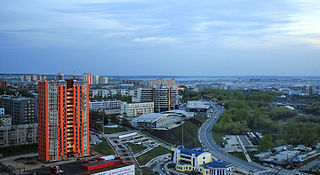
Kemerovo is an industrial city and the administrative center of Kemerovo Oblast, Russia, located at the confluence of the Iskitimka and Tom Rivers, in the major coal mining region of the Kuznetsk Basin. Population: 557,119 (2021 Census); 532,981 (2010 Census); 484,754 (2002 Census); 520,263 (1989 Soviet census).

The penultimate USSR-era flag was adopted by the Russian Soviet Federative Socialist Republic (RSFSR) in 1954 and used until 1991. The flag of the Russian SFSR was a defacement of the flag of the USSR. The constitution stipulated:
The state flag of the Russian Soviet Federative Socialist Republic (SFSR) presents itself as a red, rectangular sheet with a light-blue stripe at the pole extending all the width [read height] which constitutes one eighth length of the flag.
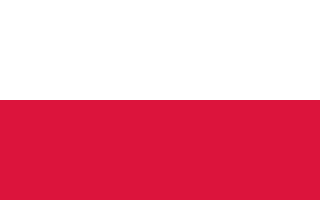
The national flag of Poland consists of two horizontal stripes of equal width, the upper one white and the lower one red. The two colours are defined in the Polish constitution as the national colours. A variant of the flag with the national coat of arms in the middle of the white fess is legally reserved for official use abroad and at sea. A similar flag with the addition of a white eagle is used as the naval ensign of Poland.

The national flag of the Russian Federation is a tricolour of three equal horizontal bands: white on the top, blue in the middle, and red on the bottom.
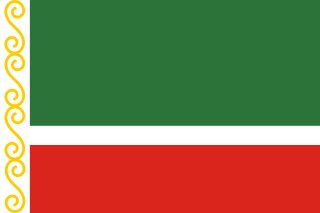
The flag of Chechnya is a rectangle with sides in the ratio 2:3 representing the Chechen Republic, a republic of Russia. The flag is composed of three horizontal bars of, from top to bottom: green, representing Islam; white; and red; superimposed on them is a narrow vertical white band at the hoist, containing the national ornament, a design of four golden scroll shapes.

Transnistria, a de facto state internationally-recognised as part of Moldova, has two co-official national flags. The first co-official national flag consists of three horizontal bands of red, green, and red, of vertical width 3:2:3, and in the upper canton, is the main element of the coat of arms of Transnistria; a golden hammer and sickle and a gold-bordered red star. The hammer and sickle fit into a conventional square, and the star, a conditional circle. Transnistria adopted this design that comprises a version of the flag of the Moldavian Soviet Socialist Republic used between 1952 and 1990 in the 2000 Law about State Symbols. The second co-official national flag consists of three horizontal stripes in the colors white, blue, and red, identical to the Russian flag but at a ratio of 1:2 instead of 2:3.

The flag of Crimea is the flag of the Autonomous Republic of Crimea in Ukraine and the Republic of Crimea controlled by Russia. The flag was officially adopted on 24 September 1992 as the flag of the Republic of Crimea, readopted on 21 April 1999, then readopted on 4 June 2014 as the flag of the Republic of Crimea, annexed by the Russian Federation.

The flag of the Russian exclave of Kaliningrad Oblast is a rectangle with a ratio of 2:3 divided into three horizontal stripes. The upper stripe is red, a thin yellow stripe in the middle and a dark blue stripe of the same size as the red bar. In the canton is a silver-and-black stylized medieval castle with open gates and the monogram of Empress Elizabeth Petrovna.

The Jewish Autonomous Oblast is the only Autonomous Oblast in Russia. It is situated in the Far Eastern Federal District of Russia.
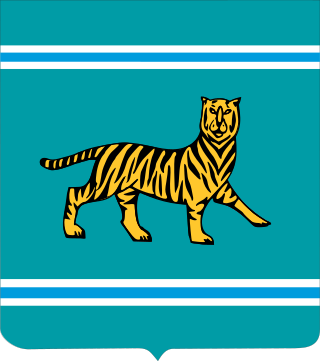
The coat of arms of the Jewish Autonomous Oblast is the official coat of arms of the Jewish Autonomous Oblast in Russia. It consists of a Siberian tiger standing on four legs with the tail and the head turned upwards, of which the latter is facing the observer. This specific position and occurrence of the tiger symbolizes the history and development of the Oblast. The coat is a heraldic French shield and the background represents the color of the geographical characteristics of the Russian Far East, which includes taigas, hills, and meadows.

The flag of Vladimir Oblast, a federal subject of Russia, was adopted 28 April 1999. The flag is a field of red with a light blue band on the hoist. The band is 1/8 the length of the flag and has a hammer and sickle at the top. The field is charged in the center with the coat of arms of Vladimir Oblast, which is 1/3 the length of the field. The ratio of the flag is 2:3.

The Flag of Novosibirsk Oblast is the official symbol of Novosibirsk Oblast, Russia.
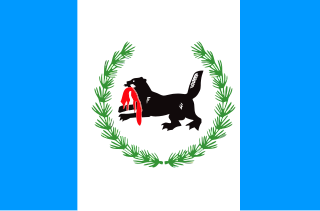
The flag of Irkutsk Oblast depicts three vertical stripes in the ratio 1:2:1: blue on the hoist and fly and white in the middle. Within the white strip, a stylized black tiger-beaver hybrid is seen holding a red sable in its mouth. These two are surrounded by branches of cedar. The blue represents the waters of Lake Baikal, while white represents purity, goodness, and honesty. The green of the cedar branches represents hope, joy, and abundance.

The flag of Novgorod Oblast was adopted on 24 December 2007.

The flag of Kursk Oblast was adopted on 17 December 1996. The flag consists of five stripes of red, silver, gold, and black in the ratio 2:1:1:1:2. The black, white, and gold stripes are defaced by the coat of arms of Kursk Oblast. The flag has a width-length ratio of 2:3 and was adopted under law N19-3KO.

The flag of Vinnytsia Oblast is a flag which, together with the coat of arms, is the official symbol of the Vinnytsia Oblast, Ukraine. It was approved on July 18, 1997.

The flag that serves as the symbol of the historical and geographical region of the Western Pomerania is divided horizontally into two stripes: light blue on the top and white on the bottom. It originated as the flag of the Province of Pomerania, Prussia, used from 1882 to 1935. Since 1996, it is officially recognized as the symbol of the historical region of Western Pomerania within Mecklenburg–Western Pomerania, Germany.

The flag of the Kherson Oblast is the official symbol of the Kherson Oblast of Ukraine, along with the coat of arms. Approved by the decision of the Kherson Regional Council No. 440 of 25 October 2001.
This is a list article about flags that have been used by pro-Russian separatists in Ukraine and in areas occupied by Russia and Russian-controlled forces during the Russo-Ukrainian War.



















